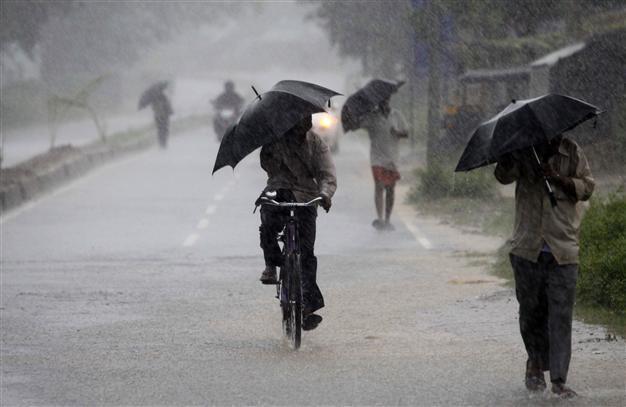Half a million evacuated as cyclone lashes India
BHUBANESWAR, India - Agence France-Presse

Villagers hold umbrellas as they walk towards a cyclone shelter in their village near Chatrapur in Ganjam district, about 200 kilometers from the eastern Indian city Bhubaneswar, Oct. 12.
India evacuated nearly half a million people as massive cyclone Phailin closed in on the impoverished east coast Oct. 12, with winds already uprooting trees and tearing into the flimsy homes.
The storm packed gusts of up to 240 kilometres per hour as it churned over the Bay of Bengal, making it potentially the most powerful cyclone to hit the area since 1999, when more than 8,000 died, the Indian weather office said.
"The very severe cyclonic storm Phailin is moving menacingly towards the coast," special relief commissioner for the state of Orissa, Pradipta Mohapatra told AFP, as it arrived within 150 kilometres of landfall.
Authorities said they expected a three-metre storm surge when the eye of the cyclone strikes in the early evening, with torrential rain also threatening floods in low-lying areas. "I've got faint memories of the 1999 super cyclone," nervous 23-year-old student engineer Apurva Abhijeeta told AFP from the coastal town of Puri, 70 kilometres from state capital Bhubaneswar.
Heavy waves pounded the coast as terrified locals made their way to solid buildings, cramming into packed rickshaws and buses as they travelled. Relief efforts were underway, with free food being served in shelters.
Food stockpiling began earlier in the week as Phailin gathered strength dramatically in the Bay of Bengal, with many shops stripped bare before they closed on Oct. 12 afternoon.
In Visakhapatnam, further south on the coast of neighbouring Andhra Pradesh state, fishermen frantically sought to secure their boats while others admired the rough surf.
Large boats could be seen anchored out at sea, while the biggest port in the area, in Paradip, has shut down.
Over 440,000 evacuatedAt least 440,000 people have been evacuated from the coastal areas of Orissa and Andhra Pradesh to the south, according to the National Disaster Management Agency (NDMA).
Vice-chairman Marri Shashidhar Reddy told a news conference it was one of the biggest evacuations in India's history, and had been aided by improved early warning systems. "We will be on a war footing," he said in New Delhi.
Authorities were still rushing to get people out of the storm's path, even those who were reluctant to move.
"We've been instructed by the government to use force in case people resist," said Mohapatra, the Orissa special relief commissioner.
In the seaside town of Gopalpur, which is expected to be one of the worst affected areas, women and children were the first to pack into shelters, schools and public buildings, where they lay on mats.
The Indian Red Cross Society also had disaster response teams ready while the air force, fresh from helping evacuate thousands from floods in the Himalayas in June, flew in food and medical supplies to Bhubaneswar.
While the storm is still technically one notch below the most powerful category of "super cyclone", the India Meteorological Department sounded its highest "red alert" on Oct. 12 morning.
Some foreign forecasters believe Phailin, which means "Sapphire" in Thai, is more intense than Indian experts are predicting.
The U.S. Navy's Joint Typhoon Warning Center said gusts could reach as high as 315 kilometres an hour, while London-based Tropical Storm Risk put Phailin in the "super cyclone" category.
It is set to strike the same coastal area that was hit badly in 1999, a region mostly populated with fishermen and small-scale farmers who live in flimsy huts with thatched roofs or shanties.
Weather officials have warned of widespread crop damage in impoverished Orissa, which relies heavily in agriculture.
It took years for crop yields to recover after soil was contaminated by saltwater during the 1999 cyclone, leaving the state dependent on aid. That storm had higher wind speeds and a larger storm surge - six metres - than being currently predicted by the Indian weather office.
The Orissa government said it was setting a "zero casualty target" in the state of close to 40 million people, and was seeking "100 percent" evacuation of people in the worst-affected areas.
Some of the deadliest storms in history have formed in the Bay of Bengal, including one in 1970 that killed hundreds of thousands of people in modern-day Bangladesh.
